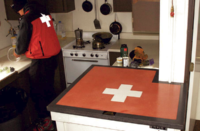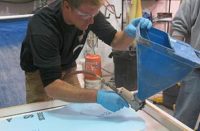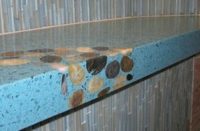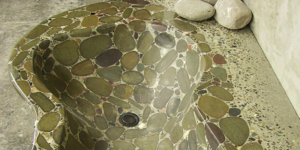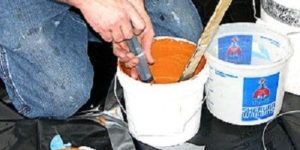
Since manufacturing portland cement damages the environment, more and more concrete makers are giving alternatives a chance.
According to the LEED certification system, concrete has several green qualities, including a long lifetime and recyclability. Portland cement, one of concrete’s primary ingredients, is another story.
Making portland cement starts with environmentally destructive ore mining. That’s followed by heating the crushed ore to 2,650 degrees Fahrenheit, a process that consumes an average of 4.6 million BTUs of energy per ton of cement. Manufacturers are reducing that energy demand by improving their processes. “Between 1972 and 2006, they’ve reduced their total energy consumption by 37.3 percent per ton,” says Terry Collins, a concrete construction engineer with the Portland Cement Association. “And they’re recycling waste for use as fuel — tires, paints and solvents, polymers, anything that will burn with a very high BTU rating.”
That’s progress, but many contractors want to make concrete even greener. Usually, this means replacing part of the portland cement in a mix with some type of pozzolan. During hydration, portland cement and water produce calcium hydroxide, which pozzolans convert into additional cement. As a bonus, less lime is available to cause efflorescence

Half a dozen pozzolans are being used in decorative concrete. Each offers different performance and environmental qualities.
Metakaolin
Also known as calcined clay, metakaolin is a white pozzolan that increases the strength and stain resistance of concrete. It can replace 5 percent to 20 percent of the portland cement in a mix. Production of metakaolin involves mining clay and heating it. The processing temperature is only about half as high as that of portland cement, so less energy is needed and the material is somewhat greener.
Silica fume
Silica fume, a waste product of steel manufacturing, strengthens concrete, but its very dark color can be a drawback in decorative applications.

Silica fume decreases workability a lot, and you have to use more superplasticizer to overcome that,” says Jeff Girard, president of the Concrete Countertop Institute. “People who aren’t that aware of what they’re doing just tend to add more water, which is really bad for concrete.” He says silica fume usually replaces 5 percent to 10 percent of the portland cement in a mix. It is available in bag quantities, although many distributors do not keep it in stock.
Slag cement
Slag cement is a waste product of blast furnaces. Slag Cement Association literature claims that it offers “improved workability, including easier placement and improved finishing characteristics.”
“About the only reason I use slag cement is it’s readily available in my area,” says Alla Linetsky, owner of Concrete Elegance Inc. in Toronto. “All the concrete I’ve made with high replacement ratios of slag cement just hasn’t held up. Right now, I use only 9 percent. Even at that level, it makes the concrete noticeably weaker and more porous.” She adds that slag cement is often not available in small enough quantities to be convenient for the decorative industry.
Fly ash
Fly ash consists of microscopic, glassy particles recovered from the smokestacks of coal-fired power plants. There are two types. As a pure pozzolan, Class F depends on the presence of cement to harden. Class C contains enough calcium hydroxide to initiate the reaction on its own. “I’ve seen mix designs that go anywhere from 20 or 30 percent replacement to a few prototypical 100 percent replacements with Class C fly ash,” Girard says.
“Fly ash greatly enhances workability, flowability, placeability and finishability,” says Tom Fox, Western regional technical support manager for Headwaters Resources, a fly ash supplier. Fly ash reduces concrete’s porosity and permeability, so it protects rebar from corrosion, he adds.
Eric Corey Freed, principal of organicArchitect in San Francisco, reports seeing contractors use as much as 85 percent fly ash, although high concentrations have significant effects on a mix. “The troweling is a lot different,” he says. “It increases the instance of pitting. We’ve found we can parge over it with a finish layer of plaster or stucco. The curing time is much longer.”
Girard notes that pozzolans can be used in combinations. “The workability of fly ash tends to offset the workability reduction of silica fume,” he observes.

However, he cautions contractors against modifying mix designs themselves unless they understand concrete very well. “There’s a scientific process to making a mix design,” he says. “I teach my own mix designs in my classes.” Another way to get help with creating and testing a new mix design is to contact a concrete test facility. Making test pieces is also an essential part of the process. Experimenting on an actual project can cost money and damage the reputations of both the contractor and of decorative concrete in general.
Portland-free
“As far as I know, we’re the only ones with a complete, no-portland product,” says Leo Kahl, vice president for marketing with CeraTech Inc. in Alexandria, Va. “Our materials are comprised of a high percentage of fly ash as well as other materials.” CeraTech’s proprietary powder is simply dry-mixed with fly ash and aggregate. “Our process is not even manufacturing,” Kahl says. “It just comes together at the point of use, so there’s absolutely zero carbon footprint with this product.”
Two versions are available. Surfix, a pigmentable and stainable gray overlayment, can rehabilitate concrete surfaces as a final application or as a substrate. Artkote, a white overlay product that can be colored and stamped, is particularly suitable for decorative finishes. Both products are intended for underroof or indoor purposes only, and neither requires a bond coat.

VCAS
VCAS (Vitreous Calcium Alumino-Silicate) is a white pozzolan made from glass-fiber manufacturing waste. Literature from the manufacturer, Vitro Minerals, says producing its product requires 99 percent less energy than an equivalent amount of portland cement. Replacing 20 percent of cement with VCAS increases paste volume 4.2 percent given a fixed water-to-cement ratio.
“Our material has all the same attributes as fly ash for replacing cement — low water demand, good physical properties,” says Jerry Turner, Vitro Minerals’ marketing manager. “Our advantage is that our material is white. In a stampable mix, we can replace roughly 20 to 25 percent of the cement. Our material makes the mix very smooth and creamy. It helps fill the fine areas in the mold or stamp, so installers get very good detail.”
“VCAS greatly reduces efflorescence and greatly reduces or eliminates alkali-silica reaction problems,” Turner says. “With time, our material reacts with the sodium hydroxide, but not so fast that surface stains don’t take hold. As the material continues to react over time, it makes the concrete less porous, so the colors stay bright and more permanent.”
VCAS plus GFRC
Steve Silberman and Tommy Cook, co-owners of Absolute ConcreteWorks in Poulsbo, Wash., use a combination of methods to reduce their use of portland cement. “Our mix design for most all of our products is glass-fiber reinforced concrete, or GFRC,” Silberman says. “Because it’s so dramatically stronger, we are able to pour it much thinner. Our basic structures are typically poured 3/4 inch or 1 inch thick — there, initially, we’ve reduced our use of portland cement by up to 50 percent, because industry standard is a 1 1/2-to-2-inch-thick pour.”
Using Vitro Minerals’ VCAS enables the company to reduce its overall portland use by up to an additional 22 percent, Cook adds.
Silberman adds that their GFRC mix uses no gravel, which has to be quarried. “If you’re looking at it from an overall green and sustainability perspective, the elimination of the gravel from the structural integrity is another eco-friendly element.”
Deco-Poz
The Deco-Poz concrete resurfacing system uses a mixture of 75 percent white portland cement and 25 percent white, recycled glass pozzolan. “Deco-Poz can be stained or coated with just about any material,” says John Bennett, president of Eco Safety Products Inc. “It has more porosity than a hard-troweled concrete or one that’s very dense with curing compound, so it actually becomes a little easier to stain.”
The product, consisting of a powder and a liquid polymer, offers another green benefit. “Our system can be applied over existing asphalt, adhesive or mastic,” Bennett says. No primer is needed, no substrate has to be removed and dumped in a landfill, and there’s no need for stripping, which creates hazardous waste.
“You can put Deco-Poz over glass, old Mexican tile or Formica tops,” says Sam Dalrymple, co-owner of Xiascapes in Carefree, Ariz. “We’ve done the insides of swimming pools with it, on top of plaster that’s rotting away.” Dalrymple says the 6,200-psi strength is double that of other products.
Making a choice
Comparing the greenness of these alternatives gets complicated because many factors are involved. The most obvious are recycling versus mining virgin materials and calculating energy consumption during production. Others, like eliminating the need to remove and discard old substrates, are less apparent. And the choice often involves trade-offs. “If you happen to be near a cement plant and they happen to be using old tires as the fuel for making that cement, isn’t that a little bit greener, versus buying (a pozzolan) that has to be shipped across the country?” Girard asks.
As Kermit the Frog said, it’s not easy being green.
